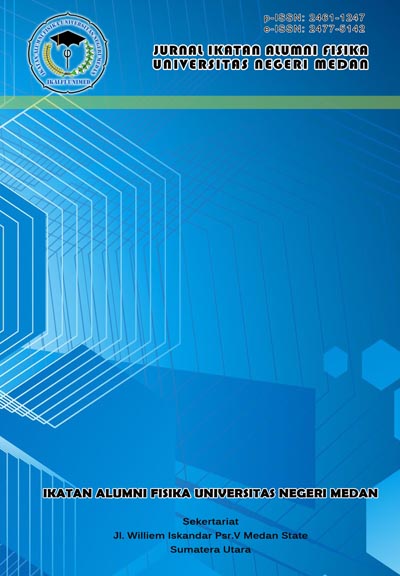PENGARUH MODEL PEMBELAJARAN INQUIRY TRAINING TERHADAP HASIL BELAJAR FISIKA SISWA DI KELAS XI SMAN 13 MEDAN
DOI:
https://doi.org/10.24114/jiaf.v5i1.12544Keywords:
Inquiry Training, Gender, Hasil BelajarAbstract
Penelitian ini bertujuan untuk mengetahui pengaruh model pembelajaran inquiry training dan konvensional, pengaruh gender terhadap hasil belajar fisika siswa, dan interaksi antara model pembelajaran dengan gender siswa dalam mempengaruhi hasil belajar fisika siswa. Metode yang digunakan adalah quasi eksperimen dengan populasi seluruh siswa kelas XI MIA SMAN 13 Medan yang terdiri dari 7 kelas. Sampel penelitian ditentukan dengan teknik cluster random sampling yang terdiri dari dua kelas yaitu kelas XI MIA “ 2 sebagai kelas inquiry training dan kelas XI MIA “ 3 sebagai kelas konvensional dengan jumlah siswa sebanyak 30 orang pada setiap kelas. Instrumen yang digunakan untuk mengumpulkan data dalam penelitian ini terdiri dari 20 soal pilihan ganda. Dari hasil penelitian diperoleh bahwa terdapat pengaruh model inquiry training dan konvensional terhadap hasil belajar siswa, dengan kriteria pengujian Fh > Ft (7,67> 4,002), terdapat pengaruh gender terhadap hasil belajar siswa, dengan kriteria pengujian Fh > Ft (5,06> 4,002), terdapat pengaruh interaksi antara kedua model pembelajaran dan gender siswa terhadap hasil belajar siswa, dengan kriteria pengujian Fh > Ft (11,99> 4,002). Berdasarkan hasil uji ANAVA yang dilakukan terdapat pengaruh model pembelajaran, pengaruh gender, dan interaksi antara model pembelajaran dan gender dalam mempengaruhi hasil belajar fisika siswa.References
Ahokoski, E., Korventausta, M., Koen Veermans, dan Jaakkola, T. 2015. Teachers™ Experiences of an Inquiry Learning Training Course in Finland. International council of association for Science education. 28. 305 “ 314
AktamiÅŸ, I., HiÄŸde, E., Özden, B., 2016, Effects of the Inquiry-Based Learning Method on Students™ Achievement, Science Process Skills and Attitudes towards Science: A Meta-Analysis Science, Journal Of Turkish Science Education, 13, (4), 248 “ 261
Alabdulkareem, S.A., 2017, Saudi Science Teachers' Perceptions of Implementing Inquiry in Science Class, Journal of Education and Training Studies, 5, (12), 67 “ 78
Anggraini, DP dan Sani, RA., 2015, Analisis Model Pembelajaran Scientific Inquiry dan Kemampuan Berpikir Kreatif Terhadap Keterampilan Proses Sains Siswa SMA, Jurnal Pendidikan Fisika, 4, (2), 47-54
Cavallo, A.,M.,L., Rozman, M., dan Potter, W.,H., 2004, Gender Differences in Learning Constructs, Shifts in Learing Constructs, and Their Relationship to Course Achievement in A Structured Inquiry, Yearlong College Physics Course for Life Science Majors. School Science and Mathematics, 104, (6), 288 - 300
Lumbangaol, D.K., dan Sirait, M., 2014, Pengaruh Model Pembelajaran Inquiry Training Menggunakan Media Powerpoint Terhadap Hasil Belajar Siswa, Jurnal Inovasi Pembelajaran Fisika (INPAFI), 2, (2), 30 - 39
Mullis, I. V. S., Martin, M. O., Foy, P., dan Hooper, M., 2016, TIMSS 2015 International Results in Mathematics, Boston College. TIMSS & PIRLS International Study Center, Diakses tanggal 05 Maret 2018 from http://timssandpirls.bc.edu/timss2015/international-results/
Mkpanang, J.T., 2016, Influence of Creative Style and Gender on Students™Achievement in Physics, Journal of Education and Practice, 7, (12), 42 “ 46
Puspedik Kemdikbud., 2017, Rekap Hasil UN, Diakses pada 22 Maret 2018 https://puspendik.kemdikbud.go.id/hasil-un/
Yamtinah, S., Masykuri M., Ashadi, dan Shidiq, A.S., 2017, Gender differences in students™ attitudes toward science: An analysis of students™ science process skill using testlet instrument, The 4th International Conference on Research, Implementation, and Education of Mathematics and Science (4th ICRIEMS)
Downloads
Published
Issue
Section
License
Copyright (c) 2019 JURNAL IKATAN ALUMNI FISIKA UNIVERSITAS NEGERI MEDAN

This work is licensed under a Creative Commons Attribution 4.0 International License.
Authors who publish with this journal agree to the following terms:- Authors retain copyright and grant the journal right of first publication with the work simultaneously licensed under a Creative Commons Attribution License that allows others to share the work with an acknowledgement of the work's authorship and initial publication in this journal.
- Authors are able to enter into separate, additional contractual arrangements for the non-exclusive distribution of the journal's published version of the work (e.g., post it to an institutional repository or publish it in a book), with an acknowledgement of its initial publication in this journal.
- Authors are permitted and encouraged to post their work online (e.g., in institutional repositories or on their website) prior to and during the submission process, as it can lead to productive exchanges, as well as earlier and greater citation of published work (See The Effect of Open Access).

